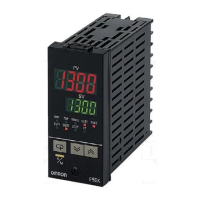CHAPTER 3 BASIC OPERATI ON
E5EK
3--10
• The hysteresis of alarm outputs when alarms are switched ON/OFF
can be set as follows.
ON
OFF
Alarm hysteresis
Alarm value
Alarm value
ON
OFF
Upper limit alarm Lower limit alarm
Alarm hysteresis
• Alarm hysteresis is set independently for each alarm in the “alarm 1
to 3 hysteresis” parameters (level 2 mode). F actory setting is “0.02:
0.02%FS”.
• “Standby sequence” is a function for unconditionally turning alarm
output OFF when the process value has left the alarm range once and
it next enters the alarm range.
• For example, when the alarm type is set to “deviation lower limit,”
generally the pro cess value is within the alarm range, and alarm out-
put become ON as it is as the process value when the power is turned
ON is smaller than the set p oint. However, if the alarm type is set to
“deviation lower limit with standby sequence”, alarm output first
becomes ON when the process value exceeds the alarm setting value
to leave the alarm range and once agai n falls below the alarm value.
JCloseinalarm/openinalarm
• When the controller is set to “close in alarm,” the status of the alarm
output function is output as it is. When set to “open in alarm,” the
status of the alarm output function is output inverted.
Alarm
Output Output LED
ON ON Lit
ose
na
arm
OFF OFF Not lit
ON OFF Lit
pen
na
arm
OFF ON Not lit
• Alarm type and close in alarm (normally open)/open in alarm (nor -
mally close) can be set independently for each alarm.
• Close in alarm/open in alarm is set in the “alarm 1 to 3 open in
alarm” parameters (setup mode). Factory setting is [
] “close in
alarm”.
The figure b elow visually summarizes the above description of alarm
operations (when alarm type is set to “lower limit alarm (deviation)
with standby sequence”):
Alarm type: lower limit alarm (deviation)
with standby sequence
Alarm value
Alarm output
(close in alarm)
Standby sequence
canceled
PV
Alarm hysteresis
Time
Close (ON)
Open (OFF)
JAlarm hysteresis
F Standby
sequence
F Summary of
alarm operations

